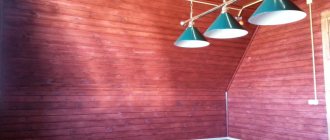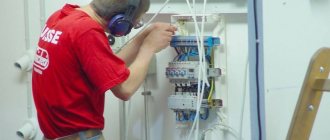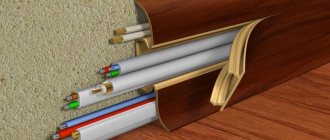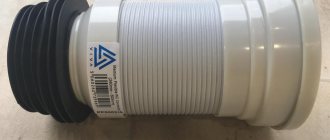Rules for the location of cable routes
The location of cable lines in the room is subject to certain rules:
- wiring in the room must be laid in accordance with strictly horizontal or strictly vertical lines, while turning the cable route is possible only by 90° (creating all kinds of diagonals related to saving conductors is unacceptable);
- horizontal sections of wiring should lie at a distance of 10...15 cm from the ceiling;
- vertical sections of wiring must be at least 10 cm away from door and window openings.
Intersection with deep communications
Before starting cable laying work, you need to familiarize yourself with the geological basis in order to correctly position all communications. We must remember that all intersections with deep-lying communications
are regulated in order to maintain security zones, as well as to create the necessary conditions for repairs. In addition, when laying in parallel, the cables should be located 10 cm from each other.
| Important! | When laying cable lines, perform protection in accordance with the PUE standards! |
Wiring types
In modern buildings, it is customary to install two types of wiring: hidden and open. Hidden wiring is laid in the voids of building structures or inside walls (in channels made by gating, drilling, etc.).
Open type wiring is laid directly on the surface of the walls. The wires are either attached to special insulators or laid in standard cable channels.
When choosing the type of wiring when building a house, you should not be guided by your own preferences, because only SNiPs, GOSTs and PUE should be taken as the basis.
“Self-taught builders” have the least questions if the electrical wiring is installed on walls made of non-combustible building materials. First, let's talk about such cases.
Air lines
Requirements and standards for laying cables along overhead power lines depend on the specific situation. Many factors are taken into account: types of cables and supports, electrical voltage, the presence of parallel/intersecting lines, weather conditions in the region, etc. The main points of the construction of overhead power lines can be given as follows: • Design features, load-bearing capacity and other physical characteristics overhead power line supports that will be used for laying electrical wiring are determined at the design stage of overhead power lines and depend on many factors - soil properties, weather conditions in the region, the type of cables used and other criteria. Compliance of the characteristics of overhead line supports with these criteria is one of the main requirements for their design and subsequent construction. • Overhead line supports should not be erected in places where their presence may interfere with the movement of vehicles and pedestrians. Otherwise, power lines are surrounded by barrier structures (baffle pipes and other structures). • When constructing overhead line supports in forest areas, cutting down plantings is not necessary. One condition must be observed here: the distance between the plantings and the lowest point of the cable sag should be 0.5 m. • Regulatory documents for laying electric cables also provide for grounding of overhead line supports and traverses.
Installation of wiring on building structures made of non-combustible materials
Modern PUE rules allow the use of wires and cables exclusively with copper conductors indoors (clause 7.1.34.).
If the room has walls and ceilings made of non-combustible materials (concrete, brick, aerated concrete blocks, ceramic blocks, GGP gypsum boards, etc.), then it is advisable to install hidden wiring in it. Firstly, it is aesthetically pleasing, secondly, it is safe in terms of accidental mechanical damage and, thirdly, the PUE rules (clause 7.1.37) completely allow for the installation of hidden wiring in walls made of non-combustible materials.
In this case we are talking about residential premises. In attics, basements (especially unheated ones) and in technical premises, it is recommended to do open wiring.
The PUE rules state: if a building structure consists of non-combustible materials, then it is allowed to lay embedded permanent wiring along it, using technological channels, grooves and voids for this. In this case, it is sufficient to use insulated cables or wires in a protective sheath (for example, VVG cables) as conductors. In this case, wiring is installed without the use of metal pipes, protective corrugations and other additional elements.
If the rough wall is subsequently planned to be plastered, then, as a rule, there is no need to resort to chiselling the walls for wiring.
station wagon 2010FORUMHOUSE member
When building a new house, before plastering work, it is advisable to carry out electrical wiring. First, it’s a good idea to obtain specifications (technical conditions) from the energy supply organization and draw for yourself (and for delivery to the same energy supply organization) a single-line power supply diagram. It is possible to ditch a brick wall, but it is not worth it. You can lay the VVG by attaching a dowel-nail to the wall and fixing the cable on it with a plastic clamp such as a tie (sold in packs in electrical goods stores). By the way, it turns out that the wiring protrudes on the wall by no more than 4-5 millimeters, and the plaster completely covers the wiring, even if you plaster sparingly with special plasters (mixtures).
Of course, niches for sockets and switches will still have to be created in the wall itself. But there will be much less dust and physical work in this case than with widespread wall gating.
As for the power supply diagram: any self-respecting owner should have it. After all, it will certainly be needed in the future. The diagram is needed at least so that during the renovation of the room you do not get a drill into a wire connected to electricity.
If you are laying wiring along walls that are not planned to be plastered in the future, then gating in this case cannot be avoided. You will also have to trench the walls if the old wiring is being replaced during a major renovation, and there is no need to remove a layer of old plaster.
Is it worth or not to create horizontal grooves? Is it possible to groove load-bearing walls and concrete floors? There are no clear answers to these questions among professional builders. Of course, from the point of view of the theory of strength of materials, man-made grooves can significantly weaken the strength of building structures (similar to how a thin cut from a glass cutter weakens strong glass). However, the rules of the PUE (clause 7.1.37) allow the laying of electrical networks in grooves (in grooves) of walls, partitions and ceilings. The main thing is not to overdo it with the depth of the groove and its width.
Kostya IvanovForumHouse Member
Make one large hole to accommodate all the cables. If the lines are different, then the distances between them are not standardized in any way. The groove should be such that the cable fits into it and does not interfere with plastering. There are no other rules here.
In this case, existing technological voids (for example, in floor slabs) should be used to the maximum.
In grooves, in steel sleeves, in special trays and technological channels, joint laying of wires and cables belonging to different lines is allowed (with the exception of mutually redundant conductors).
General principles of laying cable lines
Cable structures include cable tunnels, channels, ducts, blocks, shafts, floors, double floors, cable overpasses, galleries, chambers, and feeding points.
Cable structures must be separated from other rooms and adjacent cable structures by fireproof partitions and ceilings.
Using the same partitions, long tunnels should be divided into compartments no more than 150 m long when laying power and control cables and no more than 100 m long when there are oil-filled cables. In cable structures, measures must be taken to prevent process water and oils from entering them, and drainage of soil and storm water must also be ensured.
Inside cable structures, cables are laid on steel structures of various designs. Large cross-section cables (aluminum with a cross-section of 25 mm2 or more, copper with a cross-section of 16 mm2 or more) are laid directly on structures.
Power cables of smaller cross-sections and control cables are laid in trays (welded or perforated) or in boxes that are mounted on cable structures or on walls. Tray laying is more reliable and has a better appearance than open laying on structures.
Cable structures, with the exception of overpasses, wells for connecting couplings, channels and chambers, must be provided with natural or artificial ventilation.
Ventilation devices are equipped with dampers to stop air access in the event of a fire, as well as to prevent the tunnel from freezing in winter.
When laying cables indoors, overheating of the cables must be prevented due to the increase in ambient temperature and the influence of technological equipment (laying cables near the oil pipeline, above and below oil pipelines and pipelines with flammable liquids is not allowed). In the floor and interfloor ceilings, cables are laid in channels or pipes. It is prohibited to lay cables in ventilation ducts or openly in staircases.
Cable crossings of passages must be carried out at a height of at least 1.8 m from the floor.
Installation of wiring on building structures made of flammable materials
A lot of questions regarding the rules for installing electrical wiring arise from people who begin to independently electrify premises made of flammable building materials. We are mainly talking about frame and wooden houses. Answers to most questions can be found in the same PUE rules.
The design of houses made of combustible building materials allows for the installation of both types of wiring (hidden and open). Which one to use depends on the homeowner's preference. As for the protective elements that protect wiring from damage and the building from fire as a result of a short circuit, their choice depends on the type of cable route.
There are two ways to install open wiring indoors:
- Installation of retro wiring.
- Laying wires in cable channels.
Basic requirements and standards for laying electrical cables in the ground:
• Electrical wiring is laid in a trench with a depth of 70 cm. Cable lines for voltages from 35 kV must be protected from mechanical damage by covering them with reinforced concrete slabs with a thickness of 50 mm or more. At voltages up to 35 kV, ordinary bricks laid along the route can be used. When using armored cables, a protection device is not necessary. • The minimum trench width is 25 cm. If you plan to lay several cables, the distance between them should be 10 cm (up to 1 kV), 25 cm (20–35 kV) or more (depending on the specific situation). This must be taken into account when calculating the trench width. • Before laying the cables, a sand and gravel cushion about 10 cm thick is poured onto the bottom of the trench. • If the cables do not have metal armor, it is necessary to use protective structures to prevent mechanical damage - for example, metal / plastic pipes. Protection may also be required for armored cables (depending on the type of soil, weather conditions in the region and other criteria). • Next, the cable is again covered with sand about 15 cm thick. A warning tape or cable cover plates (CCP) are laid on top of the outer cushion, which serve to inform about the presence of electrical wiring underneath them. • On top of the warning tape or PZK, soil is poured with a reserve (after some time it will settle).
Installation of retro wiring
The extent to which the design of retro wiring complies with the rules of the PUE is a controversial issue. In this regulation, the creation of wiring of this type is not even considered. Nevertheless, let's try to understand this issue.
FDRAFORUMHOUSE Member
PUE allows open laying of cables with a flame retardant sheath (for example, VVGng) directly over walls made of flammable material. But by no means hidden. There must be visual control.
In the case of retro wiring, a special twisted cable (“retro”) is mounted directly on the wall, to which it is attached using small insulators. Considering that such a conductor is coated with artificial silk impregnated with a non-flammable composition, it can easily be classified as a fire-retardant wire. Consequently, installation of retro wiring on walls made of combustible materials does not violate the rules of the Electrical Installation Regulations.
In accordance with the rules of the PUE, the distance from the conductor to the surface of a combustible material must be at least 10 mm, which is fully ensured by the design of insulators for retro wiring.
The distances between the various retro wiring elements are indicated in the drawing.
If the wire sags a lot, the distance between the insulators can be reduced to 50 cm.
When installing retro wiring, one important nuance should be taken into account: most modern electrical appliances must be connected to a ground loop. For this reason, a three-core cable should be used as part of the wiring (if it is not commercially available, then it is advisable to weave it yourself).
Where wiring passes through a wall or ceiling made of flammable materials (for example, wood), the cable (wire) must be laid in a metal pipe that has localization capabilities. The ends of the pipe should be sealed with a non-flammable compound (for example, fire-resistant foam).
The localization ability of a pipe is a quality that allows it to withstand short circuits in electrical wiring without burning out the walls of the pipe itself. In order for a pipe to have this ability, its walls must be of a certain thickness:
- for copper conductors with a cross section of up to 2.5 mm², the wall thickness is not standardized;
- for copper conductors with a cross section of 4 mm², the pipe must have a wall thickness of at least 2.8 mm;
- for copper conductors with a cross section of 6–10 mm², the pipe must have a wall thickness of at least 3.2 mm.
Installation technology
After carrying out calculations and purchasing materials with the necessary technical parameters, they begin to install anchors and other fastening elements of electrical wiring. In most cases, they make do with steel plates, which are tightened with special pins. The rings necessary for fastening the cable are welded to them. Tension avoids sagging by evenly distributing the load along the wall.
One end of the cable is secured using loop clamps. Then screw couplings are attached to the second end in order, for example, to tension the cable between posts and bring it to the state of a string. A special bandage is used to tie the cable to the strings. For installation of cable wiring outdoors, ordinary plastic clamps, strips of galvanized iron or wire are suitable. The distance between the wire fastenings to the cable should not exceed 0.6-0.8 m.
Open wiring in cable channels
If open-type wiring is laid in cable ducts and electrical baseboards, then cables (wires) with high fire resistance (VVGng or NYM) should be used as conductors. At the same time, the material of the cable channels should also prevent the spread of fire.
Alexey S. FORUMHOUSE participant
I made open wiring with NYM wires in wood-look cable channels - Czech (with a certificate). Non-flammable (or correctly – self-extinguishing). I checked it myself: when the flame is applied, they begin to char and melt a little. If you turn off the fire, the process stops immediately.
When installed on walls made of flammable materials, socket boxes must have fireproof linings (for example, made of asbestos cement or gypsum mortar) 10 mm thick. Where wiring passes through combustible structures, metal sleeves with localization capability must be installed.
Laying power cables in tunnels
In the presence of unfavorable geodetic or natural conditions, power cables are laid in pipes and tunnels. The same work is carried out when laying the cable if it is expected to intersect with other communications or in aggressive soils.
Modern technologies make it possible to carry out horizontal directional drilling, which makes it possible to lay cables without opening the ground.
Hidden wiring in walls made of flammable materials
The peculiarities of laying hidden wiring in walls made of flammable materials (for example, wood) boil down to the fact that wiring in the voids of such walls and partitions must run inside metal pipes that have localization capabilities (PUE rules 7.1.38.).
There is only one rule, and there can be no relaxation in relation to its implementation. All other options (the use of plastic corrugation, metal hoses and other protective elements) should be obviously excluded, because from the point of view of fire safety they are unacceptable.
IK FORUMHOUSE Member
If we approach it strictly according to the PUE, then when laying it hidden over combustible structures, a metal hose cannot be laid. Key phrase in clause 7.1.38: “in metal pipes with localization ability.” Metalsleeve does not have this ability. Therefore it is illegal.
When laying wires and cables along combustible structures (or inside them), in all cases the possibility of replacing conductors must be ensured.
By the way, electrical wiring spread over the ceilings is the most convenient way to arrange hidden wiring in rooms made of combustible materials. In this case, the grooves to sockets and switches will simply go down from the main highways.
When laying pipes and ducts for electrical wiring in technological voids of combustible structures, the ends of the pipes and ducts should be covered with quickly removable non-combustible material (for example, polyurethane foam).
In order to create a sufficient number of turns when installing replaceable wiring in metal pipes, junction boxes must be used in the corners of the electrical route. Access to these elements must always remain open.
The internal diameter of the pipe should be selected in such a way that the cable laid inside it occupies no more than 40% of the total free space. This rule applies to all protective elements (cable ducts, corrugations, trays, etc.).
It should be noted right away that creating hidden wiring in rooms with wooden walls is a labor-intensive process. After all, the channels for wiring will have to be equipped on your own. Space for pipes must be cleared by drilling, making grooves and creating recesses.
Vertical channels in the walls should be drilled during the laying of the log house. In this case, horizontal holes are made after the walls are ready. To make it more convenient to pull the cable through the pipes, an auxiliary cable for pulling (conductor) should be placed in advance into their internal clearance.
Installation of cable trays
The cable tray is made of a metal profile and consists of a base with a cover into which the wires are mounted.
In addition to connecting elements, the design includes adapters, bends, turns, cross-shaped and T-shaped parts. The tray acts as a fastener for wires and cables with voltages up to 1000 Volts. The tray should not be filled with cable bundles more than 50%. Otherwise, overheating of the cables is inevitable.
The number of wires in one bundle should not be more than twelve. Wiring can be reconnected into bundles after four and a half meters when the trays are horizontal, and after about a centimeter when they are positioned vertically.
Metal trays that conduct electrical current must be grounded. An uninsulated wire or cable is extremely dangerous: it can cause electric shock. All parts of cable trays do not need to be grounded due to the fact that screw connections securely connect them to each other. It is recommended to ground the trays only in two places, in different directions of the line, and at the ends of their branches.
Cable laying under plasterboard, behind suspended and suspended ceilings
The laying of hidden wiring inside frame partitions, under plasterboard or plastic sheathing, as well as behind various types of ceilings is regulated by the set of building rules SP 31-110-2003 (clause 14.15) and the PUE rules (clause 7.1.38.). In accordance with these regulations, hidden wiring can be installed in two ways:
- If partitions, wall bases or their cladding are made of flammable materials, then conductors (for example, marked VVG) should be placed in metal pipes with localization ability, or in closed boxes.
- If building structures are made of non-flammable materials, then the wiring should consist of flame retardant wires (cables) (for example, VVGng), and it should be mechanically protected with non-flammable non-metallic boxes or pipes (for example, a corrugated self-extinguishing pipe).
In both cases, the wiring must be replaceable.
If the wiring is mounted under plasterboard sheathing, and the supporting profile is almost flush against the wall, then it is advisable to lay the wires in grooves made in the wall or plaster.
KorectorFORUMHOUSE Member
I would not make holes in the profile; you need to leave space for the wires between the profile and the wall, or ditch the wall - if there is no other way.
Rules for laying cables on a cable
In cases where other types of cable laying cannot be used for technological, design or economic reasons, cable laying on cables (on a steel rope) is used. Laying power cables on cables is used in networks with voltages up to 1 kV, both indoors (workshops) and outdoors. Cable wiring on cables indoors is carried out along columns along and across the building, as well as between walls, and outdoors - as a rule, between the walls of buildings.
For power lines laid on a cable, the same cables are used as for laying inside buildings and structures. Cables laid outside buildings, including under open sheds, must have a protective non-flammable outer covering.
The choice of cable is made depending on the load-bearing load.
As a supporting cable, ropes woven from galvanized steel wires and hot-rolled galvanized steel wire are used.
The distance between the anchors of the supporting cable should be no more than 100 m.
The distance between intermediate fastenings should be no more than 30 m when laying one or two cables with a cross-section of up to 70 mm2, 12 m when laying more than two cables with a cross-section of 70 mm2 and in all cases of laying cables with a cross-section of 95 mm2 or more. The distance between cable hangers should be 0.8... 1.0 m.
Anchor end structures are attached to building walls or building columns; fastening them to beams and trusses is not allowed.
Wiring under the floor
Installing electrical wiring under the floor is an ideal way to create hidden cabling without resorting to horizontal grooves in the walls. In this case, the cable (main wire) is supplied directly to the locations of sockets, switches and distribution boxes.
The method of creating floor wiring directly depends on what material the floors are planned to be made from. In general, it is necessary to focus on the rules of the PUE that are already known to us.
sergey_savFORUMHOUSE Member
In the voids of building structures - read SP31-110-2003 clause 14.15 or similar - PUE 7 clause 7.1.38. That is, if something in the structure turns out to be flammable (joists, for example), then the direct path is to metal blind boxes and pipes.
If the wiring is installed in the lower layers of the cement floor, then a simple protective corrugation is sufficient for its installation. Of course, it is possible to lay a cable inside the screed without any corrugation at all, but in this case it will not be possible to replace the wiring without resorting to destroying the floor covering. By the way, the difficulty of repairing and replacing cables (wires) is the only significant drawback of floor wiring, and it should definitely be taken into account when deciding on the type of electrical wiring.
So, we have introduced you to the main methods of installing internal electrical wiring, which depend on the characteristics of the building materials in the room. You can read in more detail about the experience of laying cables on various building structures in the corresponding section of our portal. You can learn about additional features of installing wiring on walls, floors and ceilings from the corresponding video. And the article about protecting consumer electronics from sudden voltage surges will be of interest to anyone who does not want to one day face the unpleasant consequences of such a problem.











